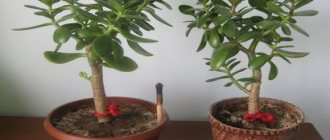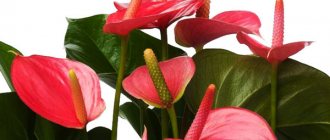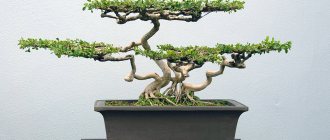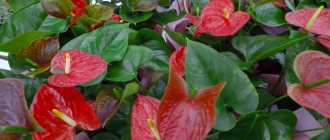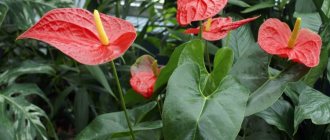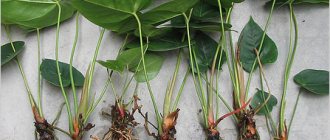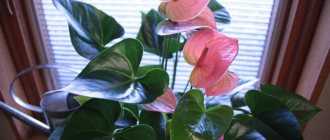In this article you will learn about the conditions for caring for anthuriums at home and transplanting a young anthurium after purchase.
House Anthurium is a special plant brought to us from countries with a hot, humid tropical climate. In addition, the anthurium flower in its natural environment often grows not even on the ground, but on tree branches, using the bark as a nutrient medium. You should take all these features of anthurium into account when caring for it at home. Below we will provide brief recommendations on how to care for anthurium in summer and winter, how to water anthurium, how to properly replant anthurium and other information necessary for every anthurium grower.
After purchasing an anthurium, check the soil moisture
As soon as you receive a parcel with anthurium or buy it in a store, check the soil moisture. The shipment may take several weeks and the soil of the plant may dry out completely along the way. In stores, too, they do not always pay due attention to the plants and often dry them out or, on the contrary, flood them, so that they begin to hurt and rot. Often anthuriums brought from abroad are in transport soil (temporary), which must be replaced after purchase. If you bought an anthurium in our nursery, you do not need to change the soil, but you must water it, since when sending anthurium by mail, we deliberately do not water it for several days. A humid environment in the absence of light can provoke root rot.
When to replant anthurium
If you purchased an anthurium in a store, you should definitely replant it in a more comfortable container than the one in which it was sold, at the same time making sure that the condition of the plant’s roots is satisfactory. This must be done within three days after purchase.
- Jacaranda - care, photos, types
If you decide to transplant your own anthurium, then it is better to do this in the spring and summer. Reasons for transplantation may be the following:
- the pot has become small: the roots have entwined the earthen ball so that the soil is almost invisible, and the pot is about to crack or a root is hanging from the drain hole of the pot;
- The composition of the soil in the pot has changed greatly for the worse, as evidenced by a white or rusty coating on the surface of the soil. The depleted substrate needs to be replaced and the plant needs to be replanted.
On average, a young plant that is less than four years old needs to change the substrate followed by replanting annually; older plants are replanted once every two to three years.
How to determine when to water anthuriums
The need for watering can be easily checked by weight; if the pot is too light, then most likely the soil is completely dry. You can check it in another way, for example, stick a wooden stick into the ground or just use your finger. The anthurium needs to be watered when the soil in the pot dries out more than halfway. Follow this rule: In order not to “flood” the anthurium, the soil in the pot should dry almost completely between waterings. You can water abundantly, but be sure to drain the remaining water from the pan. Stagnant moisture at the bottom of the pot is the worst “enemy” of anthurium. Although this plant lives in hot and humid climates, its roots grow in a loose and breathable substrate, which consists of pieces of bark, small pebbles, moss, etc.
Video on how to water anthurium.
How to transplant and rejuvenate an old anthurium?
Anthurium is characterized by aerial roots, with the help of which the adult plant is rejuvenated. There are three ways to root the apical cutting:
- It is necessary to cut off the top of the plant with several rudiments of aerial roots and plant it in loose soil. We take a small container and do not bury the socket. To keep the soil loose, add a little charcoal, moss, vermiculite, coconut fiber and pine bark. Water the seedling abundantly so that water flows out of the drainage holes.
- We wrap the top of the flower with moss and regularly spray it with water until the roots grow through it. After this, we carefully cut off the top along with the roots and plant it in a new place.
- We cut off the tops and place them in a small container with water and wait for the roots to form. Then we transplant the plants into pots.
Anthurium care after purchase
After purchasing an anthurium (or receiving a parcel), do not rush to transplant it into a new pot. The plant tolerates a long road or a long stay in the store (base) very poorly. And, if after purchasing you immediately replant it, you will increase the stress state of the anthurium, its leaves will begin to turn yellow and darken, and sometimes the plant may even die. Let the anthurium stand in your home in a warm, lit place (out of direct sunlight) for a couple of weeks. Water it with settled or rain warm water, spray the leaves every day. You can’t spray flowers, they will get stained! Wipe its leaves on both sides with a damp sponge to remove dirt and bacteria. And only after 2 - 3 weeks of adaptation to the new room conditions can the anthurium be replanted.
Caring for anthurium after purchase. What conditions need to be created for anthurium at home.
After care
To maintain a flower, it is important to create a favorable environment - the temperature should be 20-25 degrees , and the plant loves the sun very much. In addition, anthurium is accustomed to high humidity, so from the first days of purchase it is necessary to establish a watering regime and provide the plant with moist air.
Immediately after transplantation, the plant cannot be fertilized until new flower stalks appear on it. This will happen after about 2.5 months. After they appear, use special products to achieve lush flowering.
Transplanting anthurium into a new pot
An anthurium division purchased at a nursery needs to be replanted, since it is in a temporary container (plastic cup) and after purchase you need to prepare the soil and a permanent pot. We use a plastic cup not only because of its low cost, but also to control the adherence of the cutting. The appearance of new roots is clearly visible through the transparent walls.
Video of anthurim transplantation after purchase.
Anthurium needs to be replanted periodically as the root system grows. Until the age of five, the transplant can be performed every year, then every three years. When replanting, the roots are inspected; if there are any diseased or damaged roots, they are cut off and the sections are treated with crushed coal. For more information about transplanting anthurium, watch the video on our channel or the material in this article: Homemade anthurium: transplantation at home.
When and how often does male happiness need a transplant?
Young anthurium up to 4-5 years old is subjected to this procedure annually. In addition, an indoor flower needs replanting, changing the pot and soil in the following cases:
- after purchasing in a store;
- the plant has become crowded, because the root system has completely filled the pot and is peeking out of the drainage hole;
- the flower is sick, develops poorly, turns yellow, becomes covered with dark spots or withers;
- the old bush needs rejuvenation;
- the plant is damaged by pests.
The best time to renew the soil and planting container is the beginning of spring. An anthurium transplanted into a new container will quickly take root and grow if satisfactory conditions are created for it.
Attention! Male happiness over 5 years old is transplanted no more than once every 3-4 years, unless there is a special need for this.
After the purchase
An anthurium purchased in a store should not be replanted immediately; it would be correct to give the plant time to adapt to new conditions. The planting container and soil should be prepared in advance. And besides, it is advisable to choose a permanent place for the flower where it will be comfortable.
Important! When transplanting a home crop, it is necessary to carefully examine its root system to identify diseases or pests.
How to treat the roots?
If necessary, the affected areas are washed with a weak solution of potassium permanganate, trimmed and disinfected with wood ash.
Soil for anthuriums
Regular soil from your garden cannot be used for anthurium. Buy special soil for aroid plants, but it’s better to make it yourself. We have an article and video on how to make soil for anthurium. But in short, you will need five components: high-moor peat, pine bark chips, perlite, charcoal and sphagnum moss. Learn more about how to make soil for anthuriums: Soil and peas for anthuriums.
Preparatory stage
All that is needed for the preparatory stage is a properly selected pot, soil, drainage and the plant itself.
Which pot to plant anthurium in?
Transplantation and propagation of guzmania at home
You should not choose a spacious pot; it is better to choose those in which the root system will completely enter, but at the same time the container will not be too wide and deep. There should not be large spaces left, otherwise the development of the green part will slow down and flowering will not occur for a long time.
What kind of soil is needed?
Anthurium is a flower that will feel good only in a very loose substrate. Therefore, even when purchasing soil designed specifically for these plants, it is worth adding perlite or some other baking powder. An optimal soil mixture should provide access to oxygen and allow water to pass through well.
Attention! If you make a mistake with the choice of soil, the flower will begin to wither, turn yellow, its growth and development will slow down, and the young plant may even die.
There are different mixture options into which it is recommended to replant anthurium.
First:
- ready-made mixture for planting orchids;
- crushed charcoal;
- a little turf.
Option for a self-prepared composition:
- sphagnum;
- peat;
- coconut fiber.
In this case, all components must be mixed in equal proportions.
Advice! The top layer of soil taken from a spruce forest is also suitable for renewing the soil. But such a mixture must be disinfected with a manganese solution.
How to treat flower roots
When transplanting an adult tall plant with a large number of aerial roots, the processing process can be minimized or not carried out at all. To replant a healthy adult plant using the transshipment method, additional processing is not necessary.
When replanting after purchasing a flower or if the plant does not like the soil, be sure to clean the roots and keep them in a solution of potassium permanganate. You can use any other disinfectant from a specialized store. If the roots had to be cut, the cut areas are most often sprinkled with crushed charcoal.
Which pot is best for anthurim?
By placing a young small anthurium in a large pot, you create a too humid environment for it; in large peas, moisture evaporates less well. Plant the anthurium in a relatively tight pot; in such conditions it will feel better and, most importantly, the tightness stimulates its flowering instead of root growth.
When replanting, choose a pot that is slightly larger than before, 2-3 cm larger in diameter. You need to choose a plastic pot with soft walls to make it easier to pull out the root ball. In addition, thin walls warm up faster and the soil in the pot dries out better; moisture does not stagnate as much as in a ceramic pot. An anthurium pot must have holes in the bottom, and there must be a tray underneath to collect residual water. After all, the soil of the anthurium does not hold moisture well; most of it flows to the bottom. That is why dried anthuriums should not be watered, but soaked in a bucket of water. By the way, be sure to drain any remaining moisture from the pan.
Preparatory work
First, dishes for the flower, drainage and soil for the anthurium are selected.
Flower pot
Anthurium Scherzer - home care
Pay attention to the material of the flowerpot. The dishes must maintain the same temperature of the potting substrate and the surrounding air. Plastic and glass containers work well in this regard.
A clay container is only useful if it is glazed on the inside. In a simple clay container, the surface of the walls is covered with pores, the flower will begin to grow roots into them. When the time comes to transplant, this cannot be done without trauma to the roots.
The shape of the flowerpot needs to be wide and shallow, this is necessary for water drainage. There should be drainage holes at the bottom.
In a wide container, the plant will not be able to quickly cover the entire area. Pathogenic flora will begin to develop in free soil. Each pot should be 2-3 cm larger in volume than the previous one. For an adult plant, a pot with a diameter of 24-32 cm is enough. With each replanting, the depth of the pot is increased.
If the purpose of transplantation is children and side shoots, then take a spacious container, but the crop will not bloom. When they want beautiful flowering, they use tight containers.
Important! A new flower pot is disinfected with laundry soap and doused with boiling water.
Priming
The condition for a flower to be decorative is the correct substrate. The soil for exotic anthurium must meet the following requirements:
- acid balance pH 5.5-6.5;
- the substrate retains moisture well;
- dries easily;
- allows air to pass through.
Novice florists want to know what kind of soil is needed to grow anthurium. The soil required is light, but capable of supporting an adult plant. The drainage layer should be half the size of the pot so that the water drains easily. In this case, the roots are not in danger of rotting.
Important! Bark, coal, and expanded clay are added to the soil for breathability. Epiphytes can grow in a container with moss and bark, but then they will have to be constantly fed.
Agricultural pavilions sell soil mixtures for all indoor greenhouse plants. But what ready-made soil is suitable for anthurium is the answer from exotic experts. There are no special types of soil for the crop. There are formulations for orchids and all aroids. Universal soils for home floriculture, which are sold in agricultural companies, are not suitable. They need to be diluted with peat, sphagnum moss, expanded clay so that the soil does not become compacted.
The soil for anthurium should be loose
You can prepare the soil mixture yourself in the following proportions:
- peat, leaf and coniferous soil, river sand (1: 1: 1: 0.5). Improved with charcoal, conifer bark;
- leaf and turf soil, sphagnum moss (2:1:1);
- peat, pine bark, expanded clay (1:1:1);
- peat, leaf soil, sphagnum moss (3:1:1). Improve with broken bricks, coarse sand, charcoal;
- peat, moss, pine bark, perlite (1:1:1:1). The composition is suitable for young plants.
The soil is kneaded with your hands so that it fits tightly to the roots for better nutrition. As they grow, the roots become bare and protrude above the surface. They are covered with damp moss and peat.
Important! Before planting a flower in new soil, it is rid of pathogenic microflora: frozen, calcined in an oven, steamed in a water bath.
Anthurium transplant
Transplantation is carried out within the average rules for greenhouse crops.
How to transplant an anthurium at home, step by step process:
- Water the flower abundantly and let it stand for 15-20 minutes so that the earthen lump becomes soaked.
- Take the bush by the stems closer to the soil.
- Remove the plant along with the soil.
- An inspection of the roots is carried out: rotten and diseased ones are cut off, and healthy ones are treated with the drug phytolavin.
- The bush is placed in the center of the container, with soil added to the sides.
- Water with settled water.
- Place in a pre-selected warm place. Drafts and direct sunlight are contraindicated.
Note! Flowerpots are filled with soil carefully. It contains pieces of bark, stones, and turf. These elements are pushed with a stick, trying not to damage the roots. The pot is tapped on the walls several times so that the soil lies evenly. They crush it with their fingers.
Caring for anthuriums in winter
In winter, watering the anthurium should be reduced and you can even lower the temperature a little, but not below plus 18 degrees. If pots with anthuriums are placed on a windowsill in winter, make sure that the leaves do not touch the cold glass, as the anthurium may get sick. Anthurium is a shade-tolerant plant, but the plant needs a lot of light. The light should be diffused, without direct sunlight, otherwise the leaves and flowers will lose their attractive appearance. In low light, anthurium does not grow or bloom!
How to water?
The watering regime for anthurium directly depends on the time of year. In hot weather it should be intense and carried out as the top part of the soil dries. With the onset of cold weather, not so much moisture is required, so watering is gradually reduced (to about once a week).
The main problem with indoor anthurium is stagnation of water in the roots, so
after each watering you need to empty the tray .
The water should be drained after 30 minutes. Watering should be carried out using two methods - directly into the pot with the plant and into the tray, alternating them with each other. This technique will avoid stagnation of moisture and protect the roots.
The water should be soft, without any impurities, and its temperature should be familiar to the flower. To soften, you can use citric acid or soften water by freezing, settling or boiling.
Anthurium loves high humidity. This epiphyte will need regular spraying, and once a week you can give it a warm shower.
When will the baby anthurium bloom?
A very small anthurium plant (baby) will bloom no earlier than in three years. Consider this when choosing the size of anthuriums.
In this video you will see what an anthurium flower, which is sometimes called a male anthurium flower, looks like. The video shows the flowering of 10 varieties of anthurium.
In this video we will give advice on which pot to choose for anthuriums, including which pot is suitable for growing orchids.
Have you bought an anthurium flower or are you going to buy a male happiness flower? Be sure to first study the recommendations for caring for anthuriums at home. In this video we have collected basic recommendations for caring for anthuriums.
Anthurium: transplantation at home
The flower was brought from South America. There it grows under the rainforest canopy, where it is warm, dark and humid. Some similar conditions are created at home. In Russia, the flower has been known since the end of the 19th century.
Anthurium is found in almost every apartment
In nature, the flower is epiphytic - it grows on trees or settles on a pile of fallen branches, vines and leaves, but does not feed on their juices. Its aerial roots extract useful substances from the environment. There is enough moisture in the tropics; it provides everything necessary for the life of a culture.
The beauty of anthurium is in its leaves. They are shiny, matte or leathery, large, heart-shaped, round, dissected.
The flowers are often red. They are loved for their shape - a blanket with a cob in the middle.
An indoor flower can be compact (30-35 cm) or tall up to 50 cm.
For your information! Experienced florists consider the flower undemanding, while beginners consider it capricious. The main thing that is needed for its proper development is to create conditions for growth and, if possible, do not change them.
They disturb the flower during transplantation.
When to replant anthurium
Plants are considered young up to four years of age. According to average rules, they are replanted every year, and old bushes - once every 2 or 3 years.
But anthurium transplantation is also done at other times:
- immediately after buying a flower;
- The flower has grown so much that the roots are cramped in the container. Determine this: look into the pot, if there is only a lump of roots on the surface, no soil is visible, the plant is replanted;
- roots stick out from the drainage holes, which means the dishes are tight;
- the soil has become depleted. The top layer of soil is covered with a rusty reddish coating;
- plastic dishes were deformed under the pressure of overgrown roots;
- the plant withers, does not bloom, the leaf falls off - a suspicion of disease and the appearance of a pest. Slow growth is also a signal of illness. Perhaps there is a mealybug in the roots. The flower is removed from the soil and examined. A diseased plant must be replanted;
- Another reason for the procedure is the desire to divide the bush in order to propagate the crop.
Note! When a transplant is done due to illness, the affected roots are cut off and the soil from the old pot is thrown away. It is important to know how to replant an anthurium so as not to transfer the disease to another container.
The pot from which the diseased plant was removed is boiled and treated with manganese. It cannot be used in the future without thorough cleaning.
Anthurium transplantation is done for many reasons
Buy a rooted baby or flowering anthurium
You can buy one blooming Anthurium, depending on the variety and age of the flower, in the range from 600 to 700 rubles. A rooted shoot (baby) of anthurium can be purchased from 350 rubles. If the cost of ordered indoor flowers (plants) is 3,000 rubles or more, then we add one plant for free. The minimum amount for any purchase is 1000 rubles.
We do not send plants by cash on delivery!
For the availability of anthuriums in our nursery, see the “Anthurium Catalog” section.
When choosing anthuriums, instead of the name, you can indicate the number of the flower in the photo.
Catalog of anthuriums: photos and descriptions.
Pot
The container for the anthurium should be chosen low and wide, with a hole for water outflow. Its roots grow well in breadth, but penetrate shallowly into the soil. Planting in a high pot will cause the soil undeveloped by the plant to sour and cause putrefactive processes. You can take a container of any volume and fill it with drainage not 1/4, but almost completely, leaving room for the substrate and the flower.
The pot should be plastic or unglazed clay. Otherwise, the roots will not receive enough oxygen, and the plant will be constantly depressed. In order not to spoil the interior, the container can be placed in a beautiful flowerpot.
A slightly cramped pot promotes the formation of flower stalks, a spacious one promotes the growth of many children.
How to apply for the purchase of anthuriums
It is advisable to send the application in writing to [email protected] We can accept applications by phone 89379684236 (Megafon) from 10.00 to 20.00 (Moscow time).
In your application, indicate the names (or numbers) of the selected anthuriums and the desired price of the plant (division size). The letter must include your full name, postal address with zip code and mobile phone number. The application is not binding; you can adjust (add or remove plants) and even refuse the order. Please note that the quantity of some varieties of anthuriums is limited. After receiving your application, we will contact you by phone to clarify the order details, cost, and delivery. After agreeing on the order, we will provide payment details (100% prepayment only) and send your plants by Russian Post, from the beginning of spring to the end of autumn, depending on the region.
Other plants:
Homemade anthuriums: description and care
Have you bought anthurium seedlings in our nursery? Be sure to read this material. In this article you will find a description of anthurium and recommendations for caring for, growing, and replanting them at home.
Anthuriums - video on care and cultivation
Watch the videos, which explain many of the problems with growing anthuriums and provide recommendations for care, watering and propagation.
Anthuriums - problems with keeping anthurium in winter
In winter, the anthurium is severely lacking in light, and therefore, due to lack of lighting at home, the leaves of the anthurium begin to turn yellow and a number of other defects appear.
Chlorosis of plant leaves
Chlorosis is most common in hibiscus and hydrangeas. If you grow them, you definitely need to know how to treat chlorosis.
Buy homemade hibiscus
In our nursery you can buy indoor hibiscus of different varieties. Hibiscus seedlings are sold in the form of rooted cuttings.
Midges, fungus gnats, aphids and whiteflies in plants
Midges, fungus gnats, aphids and whiteflies on flowers. How to get rid of them in indoor flowers and plants?
What substrate is needed for a phalaenopsis orchid?
The orchid needs to be replanted periodically. But the phalaenopsis orchid needs a certain soil. How to make a substrate suitable for replanting an orchid.
Anthurium propagation by layering
If the shoots lengthen significantly and the plant gradually loses its shape, the top of the stem can be used to propagate anthurium. For this part of the escape:
- free from dried scales and leaves;
- carefully wrapped with damp sphagnum moss;
- and a bag or film is secured over the improvised bandage so that the moisture does not evaporate.
After some time, the formed roots begin to penetrate the moss. Such anthurium cuttings can be cut and rooted in a separate pot. And the remaining part of the stem will soon give off lateral shoots.
Those varieties of anthurium that form long climbing shoots can be rooted by pinning the moss-covered stem directly to the ground.
Mastering all methods of vegetative propagation of anthurium does not require special knowledge. You just need to remember to maintain comfortable conditions for the culture and regular care. Read the article on the website about propagating anthuriums by seeds and leaf blades.
Plant division during transplantation
Transplanting indoor anthurium is quite often combined with the procedure of vegetative propagation of the plant by dividing an adult bush. The first division of the anthurium bush is carried out no earlier than in the fourth or fifth year. As a rule, this method is used after the plant has lost all its foliage, around January-February. The procedure for dividing a bush is quite simple and accessible even to inexperienced gardeners:
- carefully remove the anthurium from the flower pot;
- carefully divide the plant so that each part has approximately equal amounts of foliage and buds;
- the tangled and fused root system of a flower can be separated using sharp and clean scissors.
The separated plants can be planted in separate flower pots filled with nutritious soil substrate and carefully watered with settled water.
How to plant anthurium by dividing the rhizomes
For the procedure you will need:
- sharp, disinfected knife;
- specially prepared substrate;
- drainage;
- pots for young plants.
Planting and thus rejuvenating the bush is not difficult at all. How to plant anthurium by dividing the rhizome:
- Carefully remove the flower from the pot without damaging the root system.
- Cut off flower stalks and stems that are too long, but preserve the aerial roots.
- Parts of the rhizome, along with the trunk and leaves, are carefully cut off and transplanted into new pots. All cut areas are treated with charcoal.
Interesting! If you don't have coal on hand, you can use ground cinnamon. It also has some antiseptic properties.
Using this method, you can propagate anthurium right at home, growing a flower in this way is easy, and already grown plants can be given to friends and relatives. A gifted flower, according to signs, brings even more prosperity to the home than one purchased in a store.
Separated parts of rhizome
Anthurium care and diseases. Plant requirements for growing conditions in the room
Often, improper care can cause houseplant diseases.
Anthurium is a houseplant of the Araceae family, a close relative of Monstera, Dieffenbachia, Spathiphyllum and Zamioculcas. In indoor culture, Anthurium Andre and Scherzer are grown more often than other species.
Typically, these spectacular plants grow well and adapt well to room conditions, but sometimes, for no apparent reason, the plants begin to get sick. It is impossible to say that this is nonsense - after all, anthuriums, deprived of their usual living conditions, are subject to stress, like other indoor plants, so it is very important to strictly observe the requirements of agricultural technology when growing home flowers.
Under what conditions does anthurium feel great?
Lighting
The flamingo flower requires bright, diffused lighting, so the plant does not feel its best on southern and northern windows. The bright sun burns the leaves; it is too dark on the northern windowsill for buds to form.
Temperature
In summer, the suitable temperature for anthuriums is from +20 to +28C. With the onset of autumn, flowers are kept at lower temperatures. During this period, plants need around +15-16C, and for Scherzer’s anthurium, a cooler maintenance regime is established - flower buds are formed only when the room temperature drops to +12-16ºC.
From mid-January, the temperature of the plants is gradually increased, bringing it to + 20-22C.
Air humidity
The tips of the leaves can dry out for many reasons.
Anthuriums are inhabitants of the tropics, so they are accustomed to high air humidity. In indoor conditions, plants are negatively affected by dry air and drafts. Plants require additional care: daily spraying with warm soft water, placing aerial roots in moistened moss, bathing in the shower, and measures to humidify the air in the room where exotic plants grow.
In winter, when the central heating is on, the air in the rooms becomes very dry. To make anthuriums feel good, it is worth equipping radiators with air humidifiers. Pots with indoor anthuriums can be placed on a large tray with wet expanded clay. It is useful to humidify the air around the flowers several times a day using a spray bottle, being careful not to get water on the flowers.
Watering
Anthurium loves high humidity, but disappears very quickly if the soil in the pot is waterlogged. Between waterings, it is useful to dry the substrate by about ½ the volume of the pot. Water for irrigation is well protected; it is even better to water the anthurium with water from a filter. During the formation of flower buds, watering is reduced.
Top dressing
Anthuriums - flower diseases are associated with improper care. Overdosing of fertilizers is one of the possible mistakes of gardeners who have forgotten that the plant does not tolerate high concentrations of minerals.
Fertilize the plant during the period of active growth approximately once a month, while the nutrient solution for feeding is prepared in half concentration. It is best to use special fertilizers for Aroids to feed plants.
The soil
Too heavy soil in an anthurium pot can also cause plant disease. The ideal soil for planting anthuriums should have a slightly acidic reaction (pH 5-6). The soil should not cake or compact - the roots are strongly compressed in such a substrate. The best soil composition for growing anthurium:
- It is better to place a flower pot in the eastern part of the house.
- It is better to place it in the bedroom.
- Avoid being near electrical appliances that absorb energy.
Is it possible to put it together with spathiphyllum?
People call Spathiphyllum “Women’s Happiness”. These flowers are very similar in appearance and at the biological level.
Well, what could there be “Women’s Happiness” without “Male Happiness”?
Many couples start by their own flower and place them next to each other. People noticed that they grew up “hand in hand”, as if they were inseparable.
If each spouse lovingly cares for the plant, then understanding and love will always reign between them.
Caring for them is quite simple, you should follow some rules:
- The plant should be watered rarely, but abundantly. In summer no more than 2 times a week;
- Keep the flower in a warm room;
- Protect your pet from drafts;
- Place it in well-lit places, away from direct sunlight.
conclusions
The Anthurium flower is a rather interesting and mysterious plant. In the house it will not only serve as decoration and part of the interior, but will fill the room with positive energy.
This flower is able to change the fate of its owner for the better and strengthen the aura for the good. This plant can become your best friend for many years.
Transplant instructions
When starting a transplant, you should first consider two points. Firstly, anthurium juice is poisonous. Therefore, work should be done with gloves. Secondly, the roots of the plant are very fragile, which will require extreme care from you.
The day before the manipulations, water the anthurium well. You can do this using the immersion method by placing the pot with the plant in a container of water for 1 hour. We carry out preliminary wetting for the purpose of easier and less traumatic removal from the pot.
After removing from the container, carefully remove the remaining used soil from the roots. At the same time, we carefully inspect the roots for the presence of pests and rot. If there are affected areas, carefully remove them to healthy tissue. We disinfect the cut areas with cinnamon or activated carbon.
Next, we put the bush itself in order - we clean it of dry shoots and broken leaves. Be sure to remove the flower stalks, because they will draw vitality from the plant.
Add a layer of drainage to the bottom of the new pot, followed by a thin layer of soil and moss. We place the anthurium in the center, carefully straightening its roots, and begin to add soil from all sides. After the operation is completed, water and allow excess water to drain.
What should you consider before seating?
Anthurium grows into a large bush in about three to four years of life. It is this age that is most suitable for planting, because the plant has already formed a stable root system and reproduction will not harm the flower if all the rules are followed.
Important! If you plant an anthurium that has not reached the age of three or four years, there is a high probability that the small anthuriums will bloom poorly, remain weak and, in the worst case, will not take root.
Transplanting can be done from mid-February to early March (during this period the plant is at rest, so manipulation of the roots is easier to tolerate) simultaneously with replanting. As a last resort or if necessary, anthurium is planted from March to August.
Anthurium needs to be planted when:
- old flower;
- the pot has become cramped, the roots are visible in the drainage holes.
Possible mistakes
The following mistakes should be avoided during transplantation:
- incorrectly selected soil;
- dense, not loose soil;
- careless handling of the plant, especially its roots, during transshipment;
- a bad place for a flowerpot with drafts, lack of light and humidity;
- excessive or insufficient watering;
- frequent application of fertilizers;
- irregular transplants, change of nutrient soil.
Anthurium is very attractive, but needs care and proper care. It is especially important to pay maximum attention to the roots of the plant during transplantation, since they are very fragile. For good flowering of anthurium, you should carefully choose a flowerpot and high-quality soil.

